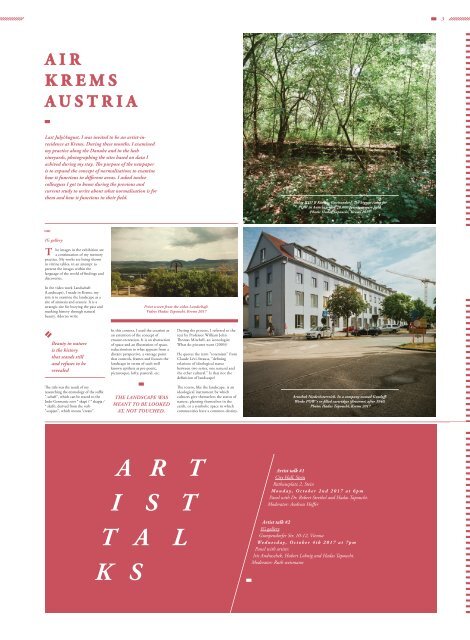Zimzum Issue 1
For more details visit hadastapouchi.com
For more details visit hadastapouchi.com
You also want an ePaper? Increase the reach of your titles
YUMPU automatically turns print PDFs into web optimized ePapers that Google loves.
3<br />
AIR<br />
KREMS<br />
AUSTRIA<br />
Last July/August, I was invited to be an artist-inresidence<br />
at Krems. During these months, I examined<br />
my practice along the Danube and in the lush<br />
vineyards, photographing the sites based on data I<br />
achived during my stay. The purpose of the newpaper<br />
is to expand the concept of normalisation; to examine<br />
how it functions in different areas. I asked twelve<br />
colleagues I got to know during the previous and<br />
current study to write about what normalisation is for<br />
them and how it functions in their field.<br />
Stalag XVII B Krems - Gneixendorf. The biggest camp for<br />
POW in Austria where 70,000 prisoners were held.<br />
Photo: Hadas Tapouchi, Krems 2017<br />
IG gallery<br />
T<br />
he images in the exhibition are<br />
a continuation of my memory<br />
practice. My works are being shown<br />
in vitrine tables, in an attempt to<br />
present the images within the<br />
language of the world of findings and<br />
discoveries.<br />
In the video work Landschaft<br />
(Landscape), I made in Krems, my<br />
aim is to examine the landscape as a<br />
site of amnesia and erasure. It is a<br />
strategic site for burying the past and<br />
masking history through natural<br />
beauty. Adorno writs:<br />
Print screen from the video Landschaft.<br />
Video: Hadas Tapouchi, Krems 2017<br />
Beauty in nature<br />
is the history<br />
that stands still<br />
and refuses to be<br />
revealed<br />
In this context, I used the creation as<br />
an extention of the concept of<br />
erasure-recreation. It is an abstraction<br />
of space and an illustration of space,<br />
reductionism to what appears from a<br />
distant perspective, a vantage point<br />
that controls, frames and focuses the<br />
landscape in terms of such well<br />
known epithets as pre-poetic,<br />
picturesque, lofty, pastoral, etc.<br />
During the process, I referred to the<br />
text by Professor William John<br />
Thomas Mitchell, an iconologist:<br />
What do pictures want (2005)?<br />
He quotes the term "totemism" from<br />
Claude Lévi-Strauss, “defining<br />
relations of ideological status<br />
between two series, one natural and<br />
the other cultural.” Is that not the<br />
definition of landscape?<br />
The title was the result of my<br />
researching the etymology of the suffix<br />
“-schaft”, which can be traced to the<br />
Indo-Germanic root * skapi / * skapja /<br />
* skafti, derived from the verb<br />
"scapjan", which means “create”.<br />
THE LANDSCAPE WAS<br />
MEANT TO BE LOOKED<br />
AT, NOT TOUCHED.<br />
The totem, like the landscape, is an<br />
ideological instrument by which<br />
cultures give themselves the status of<br />
nature, planting themselves in the<br />
earth, or a symbolic space in which<br />
communities have a common destiny.<br />
Artothek Niederösterreich. In a company named Gustloff-<br />
Werke POW´s re-filled cartridges (firearms) after 1940.<br />
Photo: Hadas Tapouchi, Krems 2017<br />
A R T<br />
I S T<br />
T A L<br />
K S<br />
Artist talk #1<br />
City Hall, Stein<br />
Rathausplatz 2, Stein<br />
Monday, October 2nd 2017 at 6pm<br />
Panel with Dr. Robert Streibel and Hadas Tapouchi.<br />
Moderator: Andreas Hoffer<br />
Artist talk #2<br />
IG gallery<br />
Gumpendorfer Str. 10-12, Vienna<br />
Wednesday, October 4th 2017 at 7pm<br />
Panel with artists:<br />
Iris Andraschek, Hubert Lobnig and Hadas Tapouchi.<br />
Moderator: Ruth weismann



